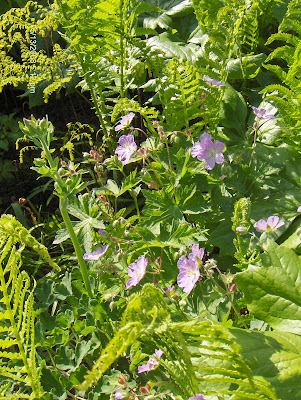It's been a very fast month. The book came out, a new issue of the magazine went to the printer, there was the farmers market and a couple of other festivals to do. In between there were all sorts of plants that burst through, needing some form of attention.
This was May of '08 in fast-forward mode.....
The week after Landis Valley Herb Faire, we went up to The Rosemary House to help celebrate their 40th anniversary. Maryanne was one of the featured artists participating, and I sold and signed books. It is still cracking me up that after 3 years, the Wild Foods for Every Table book has caught fire. It is surprising how interested people are all of the sudden. But I digress... It was fun to be a part of this momentous occasion, and watch the family together. Here are the beautiful Reppert women, toasting the past 40, and looking forward to many more. Susanna, Nancy, Marge, and Cary.
 Next is the fabulous array of herbal goodies that Nancy supplied for the celebration.
Next is the fabulous array of herbal goodies that Nancy supplied for the celebration.  My goodness, that woman can cook! The strawberries were my favorite. She stuffed them with a marscapone cheese blend and sprinkled them with crushed pistachios. I could have eaten a whole platter, but there were witnesses. Sharon Magee brought that darned "crack" pictured in the front. The saltines covered in butter, brown sugar, and chocolate. It's a conspiracy, I tell ya! I wound up bringing home a fig tree and a couple of poppies, among other things.
My goodness, that woman can cook! The strawberries were my favorite. She stuffed them with a marscapone cheese blend and sprinkled them with crushed pistachios. I could have eaten a whole platter, but there were witnesses. Sharon Magee brought that darned "crack" pictured in the front. The saltines covered in butter, brown sugar, and chocolate. It's a conspiracy, I tell ya! I wound up bringing home a fig tree and a couple of poppies, among other things. The other day I got the still out to try working with the vast carpet of chamomile out back. It took a couple of hours to get enough flowers to HALF fill the still. There was no oil, but the hydrosol is luscious. It was good to get the still cranked up. It fills the house with fragrance and puts me back in the mood to make things. I've been planting things specifically for distillation, so as they come up, I'll report in.
The other day I got the still out to try working with the vast carpet of chamomile out back. It took a couple of hours to get enough flowers to HALF fill the still. There was no oil, but the hydrosol is luscious. It was good to get the still cranked up. It fills the house with fragrance and puts me back in the mood to make things. I've been planting things specifically for distillation, so as they come up, I'll report in. We went on a tour of some other herb businesses yesterday. First we stopped at Kathy's around the corner - Cloverleaf Herb Farm. She has the sweetest farm, and the landscaping is gorgeous. Her husband John can usually be found mowing or moving something around, but they both stop and chat for a little bit.
We went on a tour of some other herb businesses yesterday. First we stopped at Kathy's around the corner - Cloverleaf Herb Farm. She has the sweetest farm, and the landscaping is gorgeous. Her husband John can usually be found mowing or moving something around, but they both stop and chat for a little bit.I loved the poppies under the sign I just had to get some for the house (nice bit of merchandising, eh?), and picked up a couple of "spare" plants of holy basil. And some other stuff too.
 This is the entrance to one of her greenhouses. No matter when we stop in, it is always neat and tidy as can be. They must work during the night.
This is the entrance to one of her greenhouses. No matter when we stop in, it is always neat and tidy as can be. They must work during the night. Next we stopped at Marian Miller's Lavender Patch Bed and Breakfast. Her gardens are just bursting with blossoms. The little gate (which leads into a lovely pool) was just covered with roses, and the peonies and flags were going nuts. Another wonderful bit of landscaping.
Next we stopped at Marian Miller's Lavender Patch Bed and Breakfast. Her gardens are just bursting with blossoms. The little gate (which leads into a lovely pool) was just covered with roses, and the peonies and flags were going nuts. Another wonderful bit of landscaping.On the way home, we had to check on the horses up the road. The babies just kill me. They run and scamper and kick up their heels, and then all at once they are exhausted and throw themselves to the ground to rest. What a life :-).













































